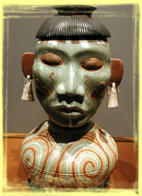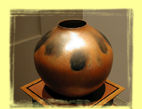




NEW DIRECTIONS IN SOUTHWESTERN NATIVE AMERICAN POTTERY
BARBARA MELLIN
Enthusiastic collectors sometimes camp out overnight, eager for first access to the annual Indian Market, a two-day event held each August in Sante Fe, New Mexico. This modern appreciation of art pottery created by contemporary Indian artists would, doubtless, seem quite astonishing to early Native American potters who created vessels for utilitarian use or ceremonial purposes. However, we must remember that even those early pots were created with artistic flourish, shaped by master artisans and decorated with distinctively Native American designs. Today, the tradition of the Native American potter continues, but with new purpose and new recognition. The collector, individual or museum, is the chief audience, now.
Even if you can't make it to Sante Fe, however, you can still view fine examples from this venue in the exhibition Indian Market: New Directions in Southwestern Native American Pottery, curated by Merrily Glosband at the Peabody Essex Museum through March 17, 2002. The Peabody Essex, a charming, eclectic museum in Salem Massachusetts, has been collecting Native American pottery for centuries, making it, as the exhibit brochure boasts, "the oldest ongoing collection of its type in the hemisphere."
The works in the show, many purchased at the Indian Market, represent not only outstanding examples of the Indian art pottery being created today, but also the wide range of interpretations that exists among the artists. Included are diminutive, precisely decorated and carefully executed seed pots, large irregularly shaped vessels, tall cylinders and nearly flat platters. Decorative details also vary from intricately painted patterns in ancestral designs to innovative renderings of color and line, and from carved surfaces to glass-like finishes.
The common element among all of the works, in addition to the ethnicity of their creators, is the method of creation. All of the pieces are hand-worked constructions: coil built rather than wheel-thrown.
Echoes of an ancient philosophy, which professes a bond between humans and the natural world and which values the spirit of natural things, can be heard in the current artists' explanation of their artistic process. "The clay speaks," says Lonnie Vigil (Nambe), one of the nineteen Native American artists included in the exhibition. Likewise, Tammy Garcia (Santa Clara) claims, "Clay has a mind of its own. The piece is a living thing during the making and drying."
Native American potters walk the fine line between preserving tradition and pursuing their personal creativity. While it would be presumptuous to make too many generalization, given the individuality of the artists, it can be said that, for the most part, today's artists recognize their ancestry and acknowledge the long heritage of pottery makers among Native Americans peoples.
Nevertheless, while some artists attempt to perpetuate the ancient art by creating vessels in traditional shapes or decorating their ports with traditional patterns, others attempt to step beyond the last footprint of the past to follow a new path with modern adaptations of ancient methods and materials. Examples of this blend of the past and present are evident throughout the exhibition.
Spirals of black and white triangles, on Seed Jar 2001, created by Dorothy Torivio (Acoma), swirl around a gracefully flanged base, which rises to a narrow opening less than an inch in diameter. The positive and negative shapes, precisely painted with a yucca brush, alternate and repeat, paradoxically forming a rhythmic motion and a sense of stability.
Spiral swirls also distinguish the seed pot of Hubert Candelario (San Felipe). However, his monochromatic, raised spirals resemble a swirl of chocolate frosting, delicate and fluid, almost ethereal.
Surfaces and shapes vary from artist to artist, and even with works by individual artists. Looking like carved wood, a pot by Tammy Garcia, decedent of Sarafina Tafoya, features a raised pattern of figures and geometric shapes. "I carve all along the process," says the artist, "when I'm polishing, when I'm sanding, and right up to the time a piece is fired." Another of her carved pieces is a rich, shiny black, which she explains comes from using horse dung as an oxygen-reduction agent during the firing process.
Particularly striking, partially because of its size — approximately two feet tall — is a beautiful, rigorously detailed, storage jar by Barbara and Joseph Cerno (Acoma). Thin, multidirectional, black and white lines cover the surface of this gracefully symmetrical pot forming an intricate star-like pattern, the delicacy of the lines contrasting with the impressive size of the vessel. Also noteworthy is a large pot by Lonnie Virgil made of mica-strengthened raw clay, whose subtle, earth-red color contrasts with dark shimmering ovals of black. Another piece, created jointly with his brother Larry Vigil (Nambe), highlights the sculptural talents of his sibling, with representations of clouds and mountains that form a decorative edge on an open bowl.
In addition to vessels of all sizes and shapes, the exhibition contains several purely figurative pieces. Portrait Head 2000 by Nathan Begaye (Hopi/ Navajo), based on Mississippian Culture (1350-1500CE), mixes bright contemporary colors with overlapping patterns, while a black- striped figure with raised hands, It's Raining, by Roxanne Swentzell (Santa Clara) sits whimsically surveying the visitors. Since childhood, Swentzell has used clay figures to communicate, especially in the years before therapy corrected her speech impediment. Yet, still today, working from a feeling, "never a sketch," the artists creates figures that communicate both a "universal nature" and a playful attitude. "If I could draw a common line through my work it would be a sense of remembering�remembering who you are, how you feel, and where you come from," says Swentzell. Her sentiment represents not only a common line through her own work, but also through all of the work featured in this elegantly presented show. That is not to say, however, that all of the work is reminiscent of the past. On the contrary, this exhibition aptly illustrates that while the pottery styles may be rooted in yesterday, they are clearly representative of today's aesthetic, felt and executed by today's artists, who are very much aware of contemporary interpretations?and the desires of collectors.
Exhibiting artists: Nathan Begaye (Hopi/Navajo) Autumn Borts (Santa Clara) Hurbert Candelario (San Felipe) Barbara Cerno (Acoma) Joseph Cerno (Acoma) Alice Cling (Navajo) Tammy Garcia (Santa Clara) Virginia Garcia (Santa Clara/San Juan) Carmel Lewis Haskaya (Acoma) Samuel Manymules (Navajo) Joel McHorse (Navajo/Taos) Les Namingha (Hopi/Zuni) Virgil Ortiz (Cochiti) William Andrew Pacheco (Santo Domingo) Diego Romero (Cochiti) Roxanne Swentzell (Santa Clara) Dorothy Torivio (Acoma) Larry Vigil (Namb�) Lonnie Vigil (Namb�)
Location: Peabody Essex Museum East India Square Salem, Massachusetts 800.745.4054 http://www.pem.org
Art Historian Barbara Mellin writes frequently about the arts. She last wrote about Azulejo, the tradition tiles of Portugal for Critical Ceramics.



All photos by Bruce A. Mellin